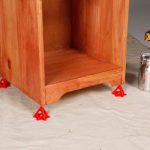We may receive a commission when you use our affiliate links. However, this does not impact our recommendations.

When I first got a look at Chuck Bender’s William & Mary bookstand in the November 2010 issue (#186),
it was clear that the piece would grace the pages of the Popular
Woodworking Magazine. The fact that a book stand from this period was
around and in a collection was amazing – you should check out the
article for a historical perspective on the bookstand. This is a piece
that I would have snapped up and built for the magazine if it hadn’t
been something Chuck brought to my attention.
If you take a look
at the stand, you have a study in joinery, William & Mary joinery.
As pointed out in the article, that translates into chunky dovetails and
not the refined super-tight pins we see in later periods. There are
mortise-and-tenon joints throughout the project and you even get a bit
of turning, too. This is a project that could be built entirely with
power tools, with nothing but hand tools or any combination of the two,
depending on your type of woodworking.
There was a bit of a problem with the cut sheet, but you can get an updated list here.
Everything else you need to build the book stand is in the article.
What you didn’t get in the article is a step-by-step description of the
finish technique that the author uses to complete the stand so it looks
as though it could sit on top of a period chest of drawers without
calling attention to itself – a 300 year old finish that was applied
just months ago. When I got to see the book stand in the Acanthus Workshops
booth at the Woodworking in America conference, I was in awe of the
finish. Also, you didn’t get a chance to see the additional photos that
Chuck had taken during the build.
Not wanting to disappoint
readers – and to get woodworkers to his visit his web site and blog –
Chuck is posting more about the bookstand. So far he has piqued our
interests about the finish and posted some of the additional photos of
the building process (everyone asks for more photos). He also says that
he’ll post even more photos, explain the surface preparation for the
upcoming finish and will eventually walk through the complete finish
method via his blog, Parings – A woodworker’s journal.
If he gives me a few extra days, I’ll get the bookstand built and I can work on the finish as he runs through the steps.
Here are some supplies and tools we find essential in our everyday work around the shop. We may receive a commission from sales referred by our links; however, we have carefully selected these products for their usefulness and quality.








Doesn’t the fact that the book support crossbar is the same thickness as the frame, and square in cross section, mean that when the frame is raised, the sharp corner of the crossbar digs into the back of the book? It seems to me that rounding at least that one corner would be kinder to your books (or iPads).
Dave,
I tried to get a photo with an iPad but Glen kept putting off mailing his to me. He kept giving me some lame excuse that he was actually "using" it for work…
Actually, I did the bulk of the build this Summer while Glen was here at my school teaching a class (the project of which will be the cover article for the December issue of the magazine). While he was here, we tested out his iPad and it fits on the stand like a they were made for one another.
No scaling necessary.
Chuck
What the article needed was a modern touch and a picture of an ipad or ebook on the stand. Just a suggestion since if I build the stand I would likely scale it for an ipad or nook/kindle electronic book reader.
-dave